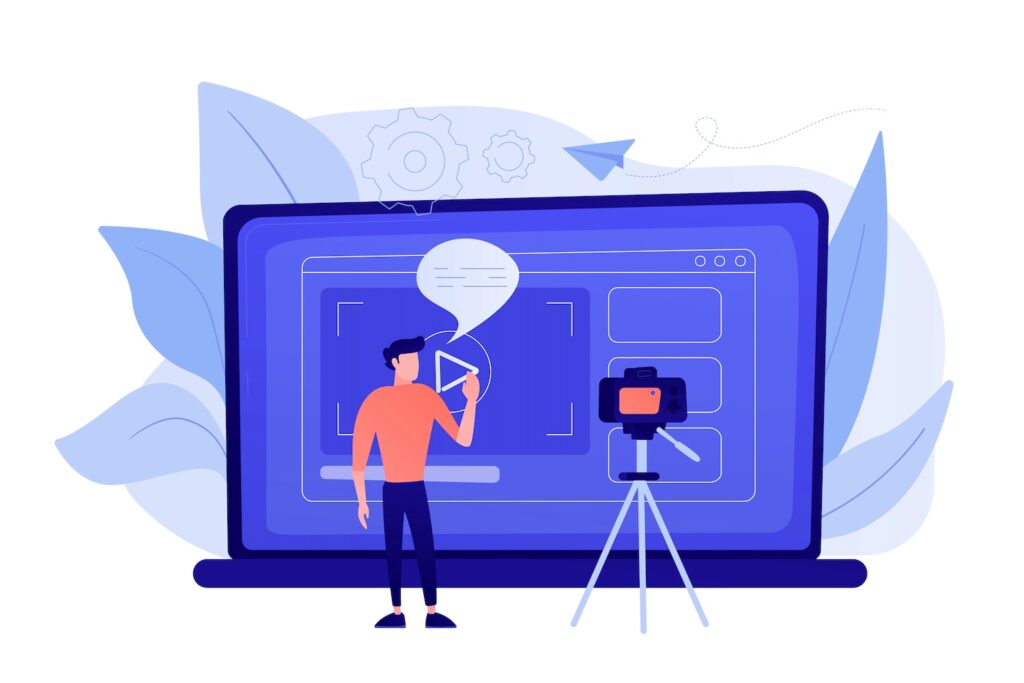
Around 51.9% of marketing professionals advocate that video content is entailed for higher ROI. B2B video marketing is the supreme tool to build long-lasting relationships with existing and new clients. The main reason behind this can be that videos hold the capacity to invoke excitement and vibrancy. For all kinds of marketing goals, videos can be generated to grasp prospective clients’ attention. We live in a time when leaving a digital video footprint in any format is not a challenging task. But, making a B2B video is more complex than one may think. Read on to understand the technicality of creating a standard B2B video.
What is exemplary B2B video marketing?
Exemplary video marketing in the B2B industry involves sharing content with B2B prospective clients. The B2B video should fascinate the prospect enough to complete a desired action for the B2B venture as the B2B video is an integral part of the B2B business plan and content marketing. B2B video marketing creators must excel in storytelling, visuals, humor, attention-grabbing colors, animation, and analyzing B2B data.
All the skill sets are crucial to go viral among executives who do commerce between firms. In Addition to the above factors, a good B2B market video should be in sync with the target audience’s intent. They cater to the audience’s needs, demands, and pain points. They are tailored according to the platform on which the video will be distributed.
The most accepted and appreciated format of B2B video content are as follows
- Explainer B2B Video
- Case Study Video
- Cultural Video
- Customer/Client Testimonial
- Direct Social Response
Explainer B2B video
An explainer B2B video is the visual representation of the product/service focusing on details like what it is and how it operates. The videos can be animated with texts, or they can also be live-action shoots. Live shoots can feature sales and marketing teams to gain the trust of prospective clients. It is crucial to do so, as 77% of the potential buyers feel that deals have become complicated.
Advantages of using explainer videos
- Explainer videos entail the capacity to engage maximum viewers in comparison to any other format of video.
- 96% of the people watch the explainer video to learn about the functionality of the products and services.
This video format is more famous in B2B ventures where the product is intangible (service, tools, and apps). Depending upon which part of the funnel is being targeted. Once the medium for displaying the video is decided, specific granular types of information can be provided to prospective clients.
Case Study Videos
Social Proof is incredibly influential; that’s why making case study videos is highly efficient. Designing a case study video that sells your brand and validates your product by real-time clients serves well for B2B businesses. It is Top-notch marketing, and every B2B venture must try it out!
Advantages of using Case study Videos
- Case study videos can establish a significant level of credibility as the client is the story, and the storyteller communicates the brand value in a video format.
- B2B ventures functioning across multiple verticals must have unique case study videos for various verticals. Showcasing the confidence many clients put in the product, all by spreading the word about their positive experience.
After all, prospective clients want to know that your products are functional and would rather hear from a client than from a brand. Consequently, B2B ventures ensure the case study video is noteworthy and appeals to a broad audience of prospects.
Cultural Videos
Cultural videos give prospective audiences a picture of what life is like when associated with a B2B venture. Cultural videos also entice clients and bring new partners and employees to your business. To achieve the desired objective of bringing in partners and employees, the organization must focus on prospective B2B data to create a concise cultural video.
Advantages of cultural videos
- Cultural videos can come in many formats, it can be a brand commercial, or else it can be about revolutionizing recruitment tools. Making cultural videos displays the company in an inside-out manner, making it look more trustworthy and accessible.
- While making a cultural video, the company can make a video about people who can run the company. Socially conscious organizations utilize cultural videos to humanize their brand. Inspire loyalty in potential consumers and clients.
Cultural video for B2B video marketing is a big yes. It not only works for B2B marketing but is also an intricate part of HR recruitment tools.
Customer/Client Testimonial
B2B Customer Testimonial Videos are where the latest and most satisfied clients express honest opinions about a product or a service. Customer testimonial videos are a great way of social proofing by utilizing user-generated content. After all, prospective clients consider social indications to understand who gets their business.
Advantages of customer testimonial videos
- Customer testimonial videos are highly effective in B2B ventures, as businesses speak industry jargon to demonstrate expertise. But, also be subtle so anyone can understand it to increase the clarity and bridge the business-prospective client’s gap.
- Secondly, the more clarity, the better, and the customer testimonial video does the same. Experienced users educate future clients about what a business provides, where it is, and how to implement it. Critical decision-making factors are touched upon in the customer testimonial videos.
Finally, yet notably, 47% of people advocate that testimonial videos are beneficial, as they guide them to visualize the product/services.
Direct Social Response
87% of video marketers believe that videos are beneficial for increasing ROI. Many also believe that that video is perfect for B2B direct response social campaigns.
Advantages of direct Social Responses
- To capitalize on the latest trends on social media, B2B direct response videos work the best. These videos were conceptualized explicitly for social media and created with specific platform-related performance marketing. Along with it, there are clear CTAs that spur clients to take action. Consequently, bringing in more leads or sales.
- Direct social response videos look quite similar to the native video advertisement explicitly created for a particular social media platform. They blend in easily with the viewer’s feed, making it easy for the viewer to interact. Last but not least, they usually cost a lot less to produce.
Trying your hands on direct social response is an excellent way to expand B2B prospects. Working on diverse social platforms keeps over interesting for the marketing and sales team as get to work with varied user personas.
These are five types of videos you should use to build brand authority. Now let’s catch up with the idea of how to strategize B2B video marketing.
Tips to Create B2B Video Marketing Strategy
Characterize Your Target Audience
Defined the audience with technographic data sources to get your video production in front of the right people. Choose to appeal to people by their job description or their level at the company. Videos would include a different message if you appeal to decision-makers from myriad industries.
Knowing a target audience also helps in deciding how to distribute B2B videos. For example, when a B2B venture plans on creating an informational video to share their knowledge. They will share emails past existing and new prospective clients directing them to a YouTube video. In case a B2B business wants to raise brand awareness and attract new clients within your industry. In that case, the best bet may be to distribute the video on LinkedIn, the leading platform for industry professionals.
Decide on What Story You Want to Tell
With defined goals and target audience, ventures can figure out what story they want to tell, and how you want to tell it. Pick the central message and build a story around it. Audiences find emotional content highly resonating, so consider how you can leverage emotions in your story to generate engagement. Studies have shown that approximately 50% of industry professionals are more inclined to purchase a product or service that utilizes emotional appeal to demonstrate personal value.
Decide On Your Platforms
Your chosen platform will inform the specifics of your video. Some social media platforms have limits on how long your video can be. Social media, in general, is made for a shorter attention span, so if you’re planning on distributing your videos there, you would likely keep them short to be most impactful.
On the other hand, if you’re summarizing a webinar or hosting a video on your company website, you would be free to play with the length and style. Social media video marketing is very powerful and doesn’t have to be complicated.
Keep Creative Requirements in Mind
Each platform, from social media to CTV, has different requirements for the creative. This refers to the size and format of each video, its audio settings, and other factors that enable the video to play on a website. Before making your video, look up the creative requirements for your chosen platform so you can be sure your own will conform. Using our detailed guides, you can learn more about social media ad specs and CTV ad specs.
Take Your Budget and Timeline Seriously
When you’re busy running your business and helping customers, it’s tempting to skip marketing. But pushing back your video production timeline to do other things gets costly. When you’ve set up your strategy, assign a project manager to keep everyone on time and within the budget.
You could add a variety of components to your video, like locations, props, etc. However, these factors can break your budget if you don’t plan for them. Have a fixed budget so you can stay within your parameters.
Polish and Perfect
A/B testing is necessary to build brand authority while working with B2B videos. It is an ideal approach for quantifying changes in the video-making procedure. Learn from each video. Take some time to recap what worked and didn’t, so you can make each video better than the last.
Test, Measure, and Analyze
When your video ad examples are done, test them to see which generated more traffic than others. Analysis of outcome details, including engagement, the time people watched each video, and others, will help you refine future videos. When shooting videos, make small changes and test these versions against each other to see which ones perform the best.
To Sum It Up
For a B2B brand to stand out in a saturated content landscape, it must invest heavily in building its video content library. The best B2B marketing video types are the ones that can touch upon every aspect of a business, not just the product that you are selling. These video types paint a more vibrant picture of a company, its culture, and the ethos of how you work with clients.
Traditionally, video production costs have been too expensive, or ads need to be more objective to be scalable. Situations have changed, and today, every organization can put out video content much more cost-effectively. It’s not too good to be true. It’s how businesses evolve. Every B2B venture should use this scenario and build a reliable B2B video content library.
Featured Image by vectorjuice on Freepik
The post Types of B2B Videos You Should Use to Build Brand Authority appeared first on noupe.



